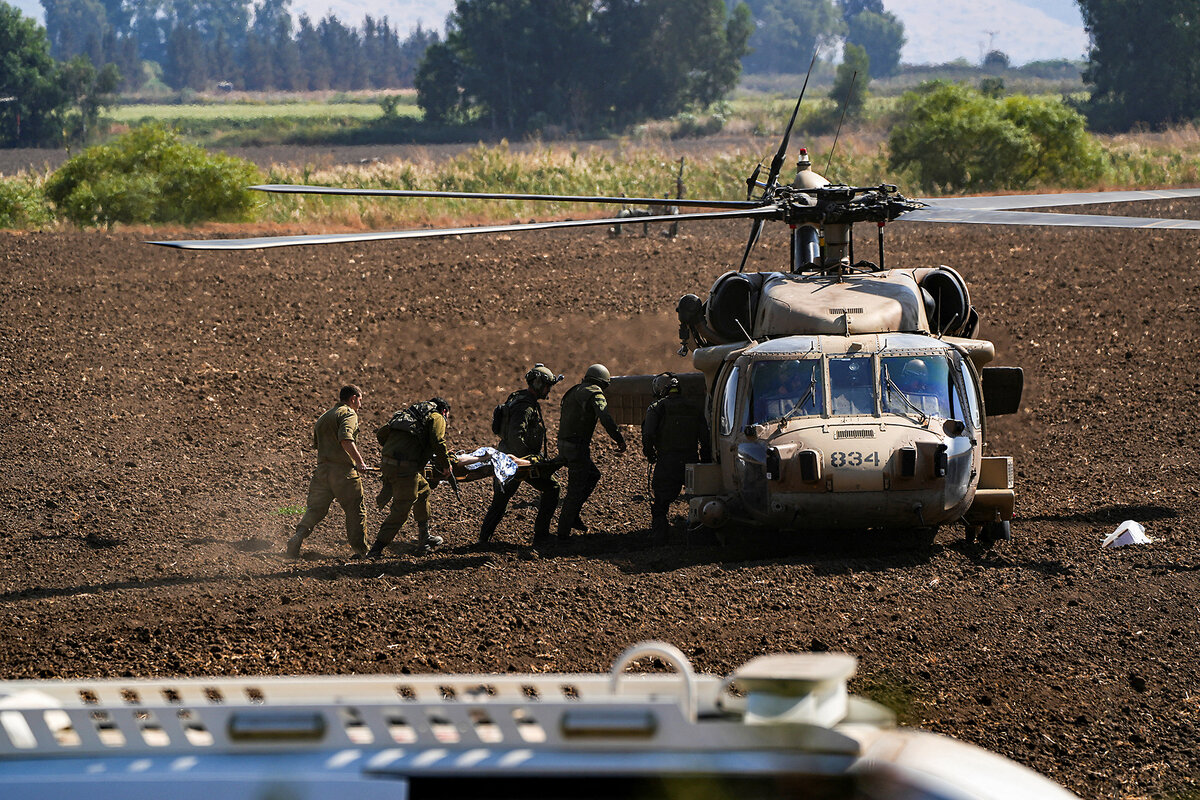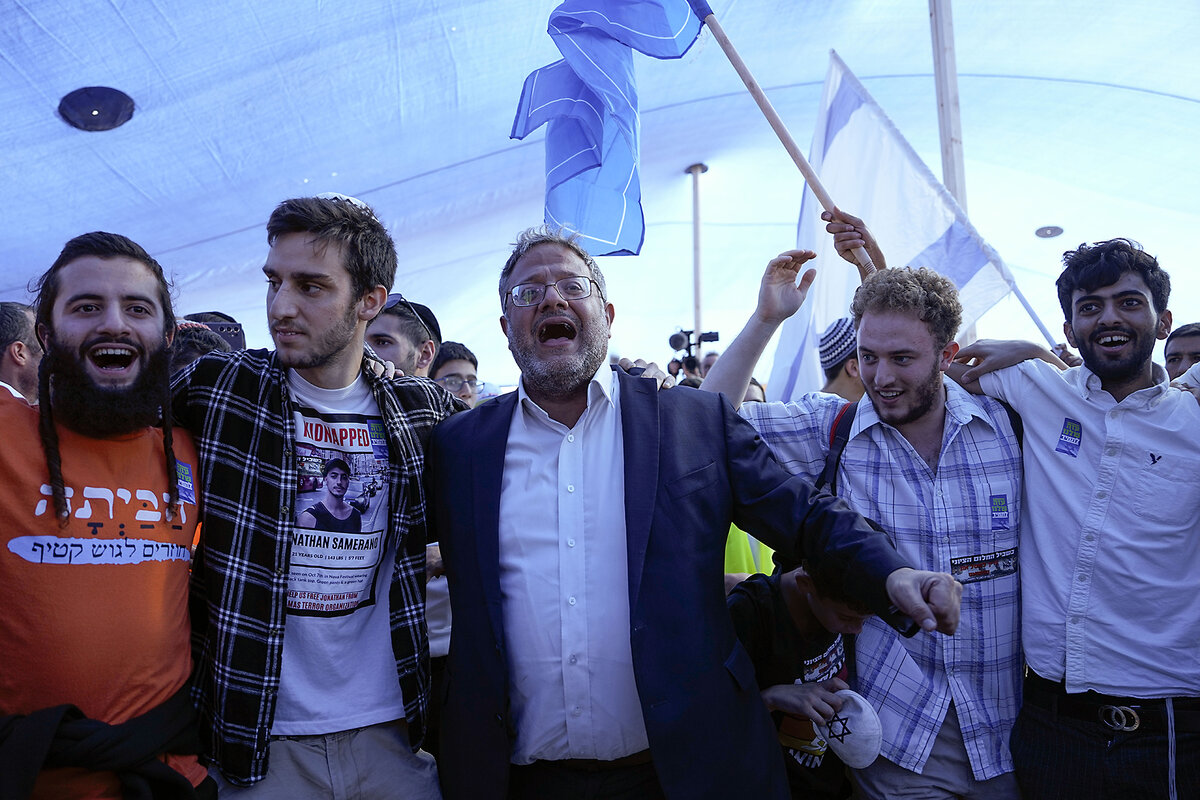Is an Israel-Hamas cease-fire possible? Pressures mount on Netanyahu.
Loading...
| Tel Aviv, Israel
The death last week of Yahya Sinwar has left the already weakened Hamas militant group leaderless. It has also added pressure on Israeli Prime Minister Benjamin Netanyahu to “seal the deal,” meaning a Gaza cease-fire that would return Israeli hostages and potentially end fighting around the region.
That is something Washington is pushing for, as made clear by Secretary of State Antony Blinken, who met with Mr. Netanyahu and other Israeli leaders Tuesday.
Why We Wrote This
A story focused onPrime Minister Benjamin Netanyahu initially described Hamas leader Yahya Sinwar’s death as “the beginning of the end” to the war in Gaza. Yet intense fighting continues. Are there any indications that pressures for a cease-fire will bear fruit?
But despite domestic and international pressures, Israeli-initiated battles in both Gaza and Lebanon rage on.
While there are indications Israel has responded to a U.S. ultimatum to increase the flow of aid into northern Gaza, halting the fighting there altogether is more of a sticking point. That said, Mr. Netanyahu recently strengthened the moderate-right faction in his coalition that could support a cease-fire in principle.
Lazar Berman, diplomatic correspondent for The Times of Israel, says there is guarded optimism in the government about an opportunity for progress toward a deal now that Mr. Sinwar is dead.
“There is a possibility for some separate deals, some smaller deals,” he says. “Israeli leaders have alluded to that when they [proposed to Hamas fighters]: Return the hostages, we’ll make sure you get out alive.”
At what has become a weekly ritual in Israeli streets in an unremitting war, rows of drummers pounded out a thunderous beat while protesters cried out in voices hoarse from repeatedly asking, “Why are they still in Gaza?”
The chant refers to the 101 hostages still held captive there by Hamas. But this time, their guttural pleas followed the killing last week by Israeli forces of Hamas leader Yahya Sinwar.
The mastermind of the Oct. 7, 2023, assault – in which mass hostage-taking was a centerpiece – he was considered a central stumbling block in winning the hostages’ release.
Why We Wrote This
A story focused onPrime Minister Benjamin Netanyahu initially described Hamas leader Yahya Sinwar’s death as “the beginning of the end” to the war in Gaza. Yet intense fighting continues. Are there any indications that pressures for a cease-fire will bear fruit?
“Now that Sinwar officially cannot be blamed as the obstacle for bringing the hostages home, full responsibility is on Benjamin Netanyahu to decide what his legacy will be: to abandon hostages or to bring them back,” says Ifat Kalderon, whose cousin is a hostage, looking on at the protest Saturday night.
Mr. Sinwar’s death has left the already weakened Hamas leaderless, though as continued combat in northern Gaza shows, the Islamic militants are still a potent force. It has also added pressure on Prime Minister Netanyahu to “seal the deal,” which would mean a cease-fire in Gaza that could also potentially lead to a regional end to the fighting – something Washington is pushing for.
But despite the domestic and international pressures, Israeli-initiated battles in both Gaza and Lebanon rage on.
“Maintaining a war atmosphere is what Netanyahu thinks is politically expedient,” says analyst Alon Pinkas, a former Israeli consul general to New York. As long as Israel is kept on a war footing, he explains, a commission of inquiry into the prime minister’s own culpability for the Oct. 7 security and intelligence failures is kept at bay, as are his corruption trial and moves to vote him out of office.
“He is thinking like a dictator,” Mr. Pinkas says. “He sacrificed the hostages, and he’s normalized daily sirens and attacks on Israel.”
Secretary Blinken’s message
On Tuesday morning about 2 million people in central Israel, including Tel Aviv, awoke to the sound of air raid sirens after Hezbollah fired rockets deep into the country, all of which were intercepted. Just hours later, U.S. Secretary of State Antony Blinken landed and began talks with Mr. Netanyahu and other Israeli officials. The State Department said the talks were centered on ending the fighting in Gaza, releasing the hostages, and dramatically increasing the flow of desperately needed humanitarian aid to Palestinian civilians in Gaza.
There’s also an understanding that Mr. Blinken, two weeks before U.S. elections, was lobbying hard for Israel to temper its planned retaliation for an Iranian missile barrage earlier this month.
Secretary Blinken “underscored the need to capitalize on Israel’s successful action to bring Yahya Sinwar to justice by securing the release of all hostages and ending the conflict in Gaza in a way that provides lasting security for Israelis and Palestinians alike,” said State Department spokesperson Mathew Miller.
In a letter last week, Mr. Blinken and Defense Secretary Lloyd Austin issued a severe warning that Israel faced a halt in U.S. weapons deliveries if it did not take immediate steps to increase the flow of aid into Gaza.
The government says it has done so, and there are indications it is exploring new options for the aid’s distribution.
According to Lazar Berman, diplomatic correspondent for The Times of Israel, the focus of Israel’s campaign now may be shifting toward dismantling Hamas’ civil governance, which would mean removing it from distributing any of the aid.
But halting the fighting altogether in Gaza is more of a sticking point.
Just after Mr. Sinwar was killed by soldiers in Rafah who came across him by chance, Mr. Netanyahu described his death as “the beginning of the end” to the war, should Hamas demilitarize and return the hostages. That language, from a leader who has resisted any talk of a “day after” the war, was seen as a possible opening.
“He did not go on to say there was room for more maneuverability, but perhaps there’s a crack there [of opportunity], although I don’t know whether to say there’s even as much as a window,” says Shira Efron, senior director of policy research at the Israel Policy Forum. She notes it also very much depends on what happens next within Hamas, whose leadership is in flux and which could even fracture into factions.
Although domestic pressure for a hostage deal does not seem to be swaying Mr. Netanyahu, there is guarded optimism in the government about an opportunity for some progress toward a deal now that Mr. Sinwar is dead, says Mr. Berman.
“Since hostages are spread around with different factions within Hamas and even outside of Hamas,” he says, “there is a possibility for some separate deals, some smaller deals. Israeli leaders have alluded to that when they [proposed to Hamas fighters]: Return the hostages, we’ll make sure you get out alive.”
Ronen Bar, head of the Shin Bet security service, who was in Cairo Sunday, is working toward reaching an initial “smaller deal” of a few hostages in exchange for a brief cease-fire, Mr. Berman notes.
Mossad Director David Barnea, he says, is talking about a broader deal to include all of the hostages, a day-after plan in Gaza, an arrangement in Lebanon, and “Israel actually winning the war” with diplomacy.
Cabinet maneuvers
Mr. Netanyahu, who saw his popularity plummet after Oct. 7, has been buoyed by recent military successes in Lebanon and a lack of any real opposition in parliament. He recently brought Gideon Sa’ar, a former rival, into his coalition, bolstering its more moderate faction.
Until now far-right Cabinet members have obstructed a cease-fire deal, especially as it would likely include the release of Palestinian security prisoners.
And herein lies another reason Mr. Netanyahu is not rushing toward a truce, says Mitchell Barak, an analyst who worked with him in the 1990s. “The problem is that Netanyahu would have to release terrorists, which he is not interested in doing – he traded Sinwar,” he says, referring to a lopsided 2011 deal in which Mr. Sinwar and hundreds of others were freed to obtain the return of a captured Israeli soldier.
But what no one in his government, the most extreme-right in Israel’s history, supports is any talk of a two-state solution, which is very much part of the international community’s vision of a day-after plan for Israel and the Palestinians. For many Israelis still traumatized by the Oct. 7 massacre, the concept is anathema as well.
“Netanyahu understands that the war will not last forever, and at some point he will need to go for a compromise. The question is when,” says Shuki Friedman, director-general of the Jewish People Policy Institute, a Jerusalem think tank. The timing, he says, will depend on Hamas being weakened enough to no longer pose a threat.
Meanwhile, the Israeli army is in the midst of an offensive in the Jabalia refugee camp in northern Gaza. The aim, it says, is to quash a guerrilla-style insurgency rebuilding there. An indication of how lethal Hamas fighters can still be, even when operating without central leadership, is that they managed to kill a top Israeli commander there Monday.
There are concerns in northern Gaza that Israel may be planning to remove civilians from that part of the enclave and push them south. It’s a policy openly endorsed by far-right ministers who are championing the idea of reestablishing a Jewish settlement bloc in the area.
Although Mr. Netanyahu has not publicly endorsed annexing a part of Gaza, and it remains a fringe concept, members of his own Likud party and government ministers attended a conference this week called Preparing to Resettle Gaza.











